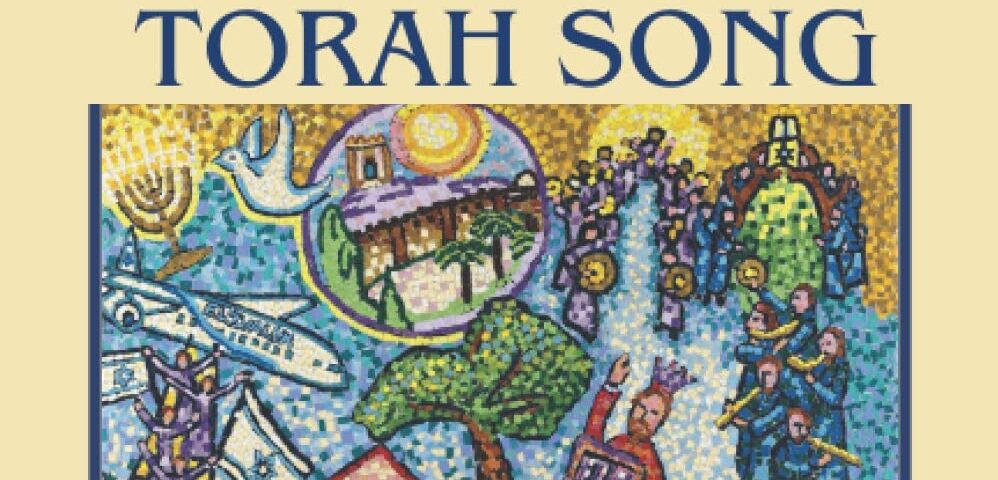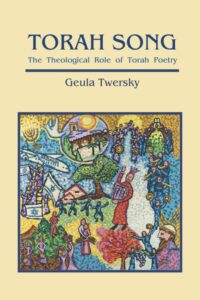REVIEW: Torah Song

 Book Review: Geula Twersky, Torah Song: The Theological Role of Torah Poetry (Kodesh Press, 2022), 220 pages
Book Review: Geula Twersky, Torah Song: The Theological Role of Torah Poetry (Kodesh Press, 2022), 220 pages
Is it possible to analyze biblical poetry? How do we fathom its religious meaning? In her recently published book, Torah Song, Geula Twersky attempts to shed light on these questions. She offers interpretations of the great poetic units in the Torah, and an underlying methodology to approach these passages.
In her introduction, Twersky evaluates several scholarly explanations of the predominant characteristics of biblical poetry and what distinguishes it from biblical prose. Poetry may be an elevated style, it contains parallelism, and has multiple layers of meaning. Nonetheless, all of these features are true for all of Tanakh. She concludes by agreeing with contemporary scholar Johannes Kabatek, who asserts that there are no set rules for poetic analysis. Rather, one can only establish a list of open possibilities (introduction, xxviii).
Twersky writes lucidly, and creatively attempts to unpack the meaning of the poems of the Torah in dialogue with all of Tanakh and oftentimes with the ancient Near Eastern context as well.
Each chapter opens our eyes to the multiple options available to interpret the multivalent words of the Bible’s poetic sections. Twersky weighs each word carefully, and then weaves together a broader tapestry of the meaning of each poem. Her book admirably combines scholarly erudition with religious inspiration.
One of the central challenges facing this methodology is that one may wonder why one interpretation is more cogent than another. If there are no set rules but only a list of open possibilities, it appears that poetic analysis has the potential to enlighten and inspire, but less ability to convince.
Running on the principle that one person’s peshat is another person’s derash, we will focus on Twersky’s essay on the Song of the Sea in Exodus. In general, her reading is plausible and she does an impressive job in demonstrating the validity of her interpretation. Yet, it is unclear why one would favor this particular reading over a multitude of other possible interpretations. The goal of this review is to explore the need for further refining of this methodology, which holds great promise to unlock the meaning of the poetic passages of the Torah.
A widespread “non-poetic” interpretation of the Song presents a linear development. Moses first praises God as an incomparably mighty warrior Who rescued Israel from the wicked Pharaoh and Egyptians. Looking ahead to the future, God’s relationship with Israel terrifies Israel’s enemies. Israel will enter its land and build a Temple, enthroning God forever. This reading appears compelling, but of course there is always room for a novel interpretation if it can be demonstrated.
Twersky takes up this challenge and develops her alternative thesis. Rather than a prayer of praise and thanksgiving, the Song instead is “a celebration of God’s coronation and an articulation of the Israelite monarchic idea” (3).
The Song is a seven-part poem, structured as a chiasm (8):
A 1-2 Statement of intent
B 3-5 God as holy warrior (third person)
C 6-8 God as holy warrior (second person)
D 9-10 Pharaoh; his hubris and downfall
C1 11-13 Praise of God’s feats
B1 14-16 Reaction of Israel’s enemies
A1 17-18 Plans for Israel’s future and for God’s coronation
Since verses 17-18 (A1) explicitly mention God’s kingship and a Temple, Twersky plugs that meaning into verses 1-2 (A). Instead of understanding aromemenhu as “I will praise-exalt him,” the word—which derives from r.v.m.—refers to construction. Anvehu, deriving from n.v.h., means “I will build Him a dwelling place” instead of “I will praise,” as the parallel with aromemenhu would otherwise suggest. Based on the putative relationship between 1-2 and 17-18, ki ga’oh ga’ah refers to God’s enthronement, rather than a more general reference to God’s glorious acts at the Red Sea.
In fact, these roots sometimes are found in the context of construction, dwelling, and God’s kingship. However, it appears that Twersky is choosing these meanings primarily because she has proposed a chiasm from the beginning. It is circular to assume a chiasm and then to interpret words according to the proposed chiasm, rather than first demonstrating a chiasm and then interpreting the words accordingly. Verses 1-2 can readily be explained as a praise of God, Who has acted gloriously through His redemption of Israel at the Red Sea.
Moving ahead to the next paired section in Twersky’s reading, verses 3-5 (B) correspond to 14-16 (B1). Both sections contain the word “even, stone”: The Egyptians sank like stones, and Israel’s future enemies are stilled like stones out of fear. Here, the corresponding sections in Twersky’s proposed chiasm work better than the first pair. God used His might to overwhelm the Egyptians, and Israel’s future enemies tremble at God’s power which will be used against them. Although no reinterpretation of words is necessary in this instance, one still may question if one similar word, even, is sufficient to argue for a chiastic structure. One can just as easily adopt the linear reading of the Song, and maintain that Israel praises God for defeating the Egyptians, and Israel also praises God for the defeat of Israel’s upcoming enemies.
In the third section (C, C1), Twersky appeals to the wider ancient Near Eastern context to inform her analysis. She quotes scholars who maintain that the Song of the Sea is a hidden anti-Baal polemic. This conclusion is rooted in certain similarities with Ugaritic Baal mythologies. There too we find watery chaos, kingship, and the building of a temple on a holy mountain. In stark contrast with these mythologies, the Song at the Sea is about God’s defeat of human enemies instead of a cosmic battle between the gods. The Song celebrates God’s relationship with Israel, rather than the relationship between deities.
To further this argument, Twersky calls attention to the expression, tir’atz oyev, shattered the enemy (v. 6). Elsewhere in Tanakh, the verb r.‘.tz. is used in the context of God defeating primeval monsters (e.g., Psalm 74:14). Twersky stresses that the mere presence of this root does not prove a polemic against these pagan mythologies, but coupled with the general parallels to the Baal myth, the case is strengthened. She also observes that in the preceding chapter, Israel left Egypt via Baal Tzephon (Exodus 14:9). Perhaps this reference in the Torah is more significant than a mere locational marker, and alludes to an anti-pagan polemic.
That all said, there is no mention of Baal, or any other pagan deity for that matter, in the Song. Perhaps Baal Tzephon was merely the location where Israel was positioned during the exodus. The term r.‘.tz. occurs regarding the defeat of human enemies in Tanakh as well (e.g., Judges 10:8). Although one cannot disprove that the Song is polemicizing against Israel’s pagan surroundings and specifically the Baal cult, there is nothing within the Song that suggests a specific polemic. The Song may simply reflect the Torah’s monotheistic perspective, rather than also taking aim at a specific mythology.
Twersky moves into the fourth section of her proposed structure of the Song, verses 9-10 (D) which illustrates the arrogance of Pharaoh and the Egyptian army. As this is the fulcrum of her chiastic structure, Twersky concludes that the Song’s climax celebrates God’s victory over evil. Once again, the Song certainly expresses this idea, but the identical point emerges from a linear reading.
Twersky makes one additional assertion: Since Israel’s kings must uphold divine justice and root out evil, the Song promotes this monarchic ideal in contrast with the wicked Pharaoh. It certainly is true that Israel’s kings are expected to be righteous and faithful to God. Nevertheless, nothing in the Song of the Sea suggests a future monarchy in Israel; it is about God’s kingship and justice.
Looking back over our discussion, most of the Song of the Sea may be explained in the identical manner, whether we read in a linear manner or instead accept Twersky’s chiastic structure. The only meaningful change in word interpretation is with regard to understanding the words in verses 1-2 as alluding to the building of the Temple and the enthronement of God, rather than viewing them as an exclamation of praise and thanksgiving to God for rescuing Israel from the wicked Egyptians. The chiastic structure remains undemonstrated, however, as there are virtually no words in common between the proposed pairs. Even, rock, is one lone example, and that hardly appears sufficient to build a thesis. In the final analysis, it appears more likely that the Song is praising God for His expression of power over the wicked Egyptians.
It is unclear that the Song deliberately polemicizes against the Baal cult, or whether the Song’s monotheistic perspective stands as its core value in its own right. Similarly, there is no reason to assume that the Song subtly refers specifically to Israel’s monarchic ideals. Israel would not have a king for centuries after the splitting of the Red Sea, and the biblical ideals of monarchy simply fall in line with the values of Godliness and justice that trace back to the very beginning of Tanakh, irrespective of whether or not Israel has a king.
None of the above discussion refutes Twersky’s reading. The entire text could be read cogently in light of her analysis. I have offered questions as a means of continuing the discussion of how one can develop a methodology for learning biblical poetry.
Twersky also writes an impressive chapter on the enigmatic Song of the Well (Numbers 21:17-20; an earlier version of this chapter appeared in TRADITION). She interprets the Song as a complement to the Song of the Sea by praising Israel as the beneficiary of God’s lovingkindness. Her exposition on the Song of Moshe (Ha’azinu; Deuteronomy 32:1-43) identifies parallels to the Torah’s narratives of creation, the Garden of Eden, Sodom and Gomorrah, Yehuda and Tamar, and the Golden Calf. Through a careful weaving together of these allusions, Moshe’s Song emerges as a meditation on Israel’s bond with God. Taken together, the three songs of the Torah highlight Israel’s eternal acceptance of God as King.
Beyond the three songs of the Torah, Twersky also explicates the poetic blessings in the Torah: Yaakov (Genesis 49), Bilam (Numbers 23-24), and Moshe (Deuteronomy 33). She uses her methodology to expound on the meaning of each blessing, and then advances a thesis of how they relate to one another and to the three Torah songs. Yaakov blesses Israel with monarchy and priesthood, which serves the kingdom of God. Bilam focuses on the relationship between human monarchy and God. Finally, Moshe stresses the connection between the priesthood and accepting the yoke of heaven.
Geula Twersky’s Torah Song is enlightening and thought-provoking. It is a remarkable effort at analyzing the major poems of the Torah, and is a creative attempt to underline how the entire Torah—and particularly its poetic passages—forms an intricate network of ideas that unite the ideology of the Torah. Twersky’s book will prompt readers to exert extra effort to fathom the divine treasures underlying biblical poetry, and to become religiously inspired through these efforts.
Rabbi Hayyim Angel, a member of TRADITION’s editorial board, is the National Scholar at the Institute for Jewish Ideas and Ideals and serves on the Bible Faculty, Yeshiva University.
